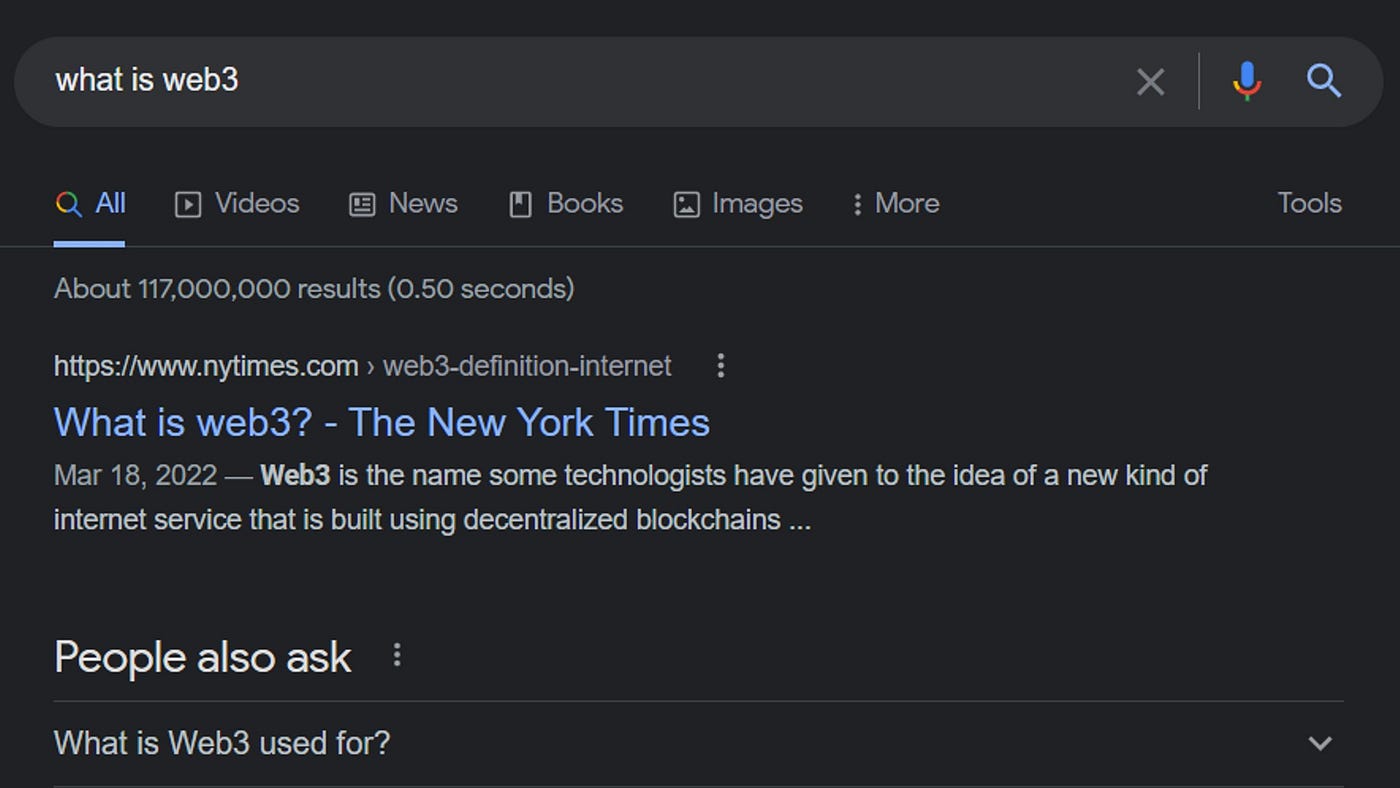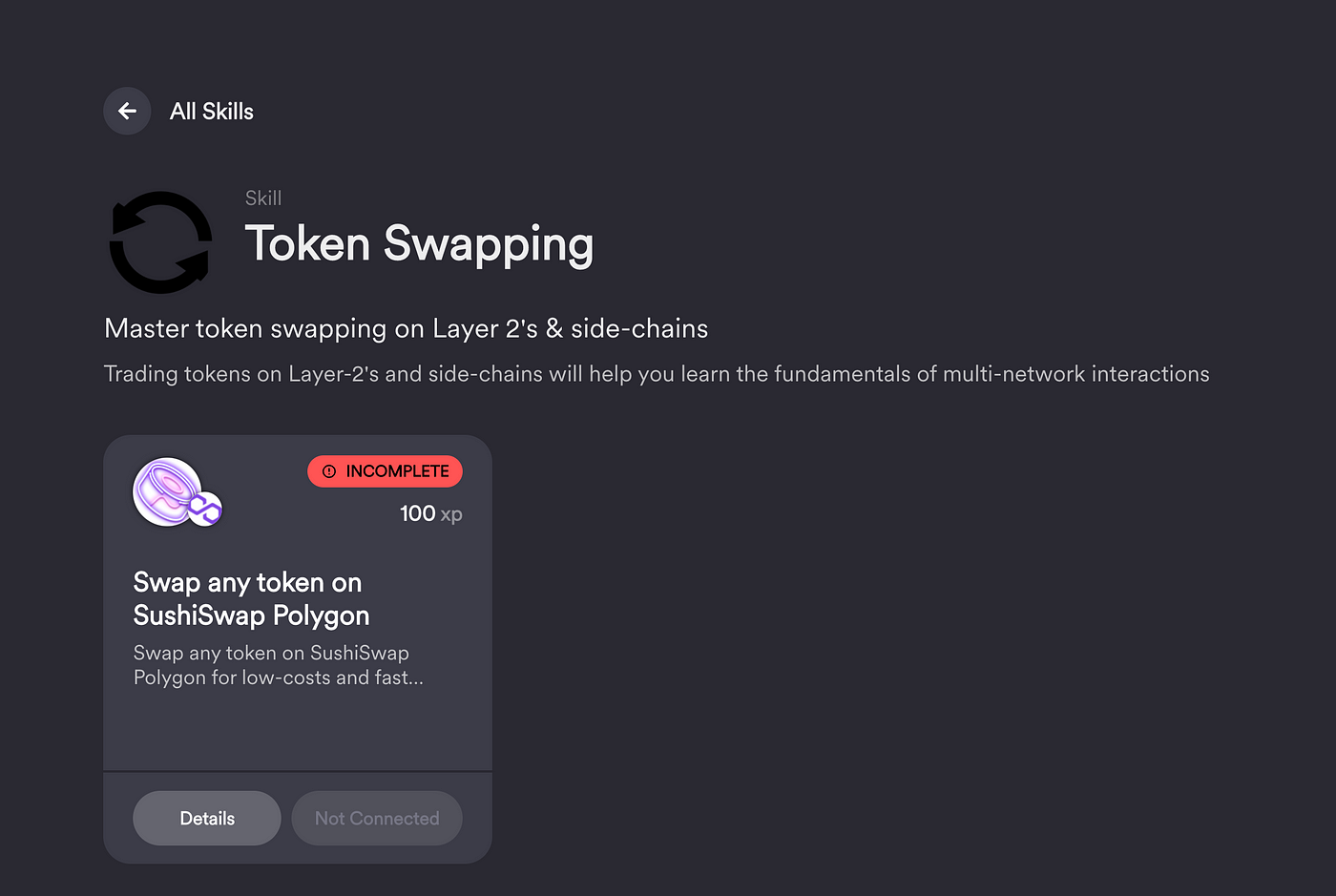This innovative technology will transform human learning

If you’re reading this on the internet, I assume you‘ve heard of Web3 at this point. It was one of the hottest buzzwords of 2021.
Proponents call Web3 the next evolution of the internet, giving freedom and ownership back to individuals. Critics call it an elitist tech trend, misaligned with human behavior and superficially inflated with VC funding.
Either way, it doesn’t really matter for the purpose of this article.
The reason I bring it up is that Web3 has a user adoption problem.
The new internet needs more users. It’s the same problem that every software company faces.
At the start of 2022, Web3 had about 300 million users worldwide. While organic user growth was strong and rapid in 2021, it’s unlikely that trend will continue forever.
Most early adopters are young, highly technical people. With billions of VC money pouring in, it’s an exciting place for them to create and innovate.
But for the regular ol’ User (like you and me), Web3 is complex, confusing, and expensive. It’s overwhelming for us non-technical folks.
“Where do I even start? How do I use this thing? What do I even use it for?”
The Web3 projects are swimming in cash, but its user base is showing signs of stagnation.
Customer Education to the rescue
In software companies, Customer Education teams help customers learn how to use and find value from software products. The goal? Boost product adoption and reduce churn.
The internet is overflowing with “customer education” resources to drive the adoption of Web3.
Do a quick Google search for “what is web3” and you’ll find about 117,000,000 in-depth guides, videos, and courses to help you learn the basics.

These more “traditional” learning mediums like articles, guides, and videos are a great way to get started.
But there are now more interesting, more useful ways to learn Web3.
There is a movement of new, innovative learning tools that offer immersive, hands-on experiences.
By focusing on “learn by doing” practices, these tools help users build skills by performing actual tasks inside the applications they’re trying to learn.
This technology alone has the power to completely transform human learning on the internet.
The most interesting and dynamic Web3 learning tool I’ve found is called Rabbithole.gg.

What is Rabbithole.gg?
Rabbithole.gg is an interactive training website that helps you learn how to use Web3. Built specifically for beginners, the platform makes it easy to get started with the new technology.
But here’s how it’s different.
Instead of watching videos or reading articles on “How To Swap a Token,” you complete real tasks in real applications. Each task you complete is automatically tracked and recorded on the blockchain.
This is an important differentiator. Forget passive learning, Rabbithole.gg is all about active learning. Your knowledge and skill acquisition comes from physically performing a series of actions within each application.
Here’s an example of how it works
On Rabbithole.gg, you can learn a skill called Token Swapping. To acquire the skill, the platform gives you a series of steps to perform.

The first step is that you must go to another app called SushiSwap, and perform the correct steps to successfully swap a token. Once you complete this task, you receive XP points and a stamped credential.
Every credential you earn is recorded on the blockchain, so you can prove to anyone you’ve completed this skill.
Pretty neat.
The core idea behind Rabbithole is that people learn better by doing.
If you want to learn about Web3, don’t take a course. Do the actions. Get a crypto wallet, buy some SOL, and purchase an NFT.
Just like if you want to learn Photoshop, you have to actually use the tool. Download the app, create a new project, and play around with the features.
Building any human skill requires active participation. Rabbithole is an early Web3 attempt at an innovative learning solution, but this technology could completely transform the future of education. Not just for software teams, but for all human learning, everywhere.
Customer training ideas for future-thinking software teams
Rabbithole’s new and experimental tech provides some interesting ideas for the future of education. Below are a few ideas that could benefit software companies in the future.
👉 Note that these are just meant to be fun, futuristic ideas right now. This technology is still new and adoption is low.
1. Scalable hands-on learning experiences, never before seen

Most self-paced training solutions rely on traditional digital media: articles, videos, courses. These are helpful, but they all lack the most important attribute of human learning: hands-on activity.
Humans learn best when they perform actions in the real world.
Sure, labs and simulations help, but nothing is as effective for learning as performing a task in the actual tool.
Imagine if you were trying to learn a new design tool like Figma. You could watch a few step-by-step videos to learn the basics.
Or, you could jump straight into the tool and start learning as you go. Learning tasks could populate within the product. Every task you complete could be tracked. Your speed, number of clicks, and accuracy.
You’d be able to see a dashboard of your learning activities — what you’ve accomplished and suggestions for improvements. Each learning activity is recorded and tracked to document what you’ve completed so far.
This level of complex data collection provides the ultimate hands-on training that could increase training time and provide broader awareness of skill gaps.
2. Skills and achievements can be verified automatically

One of Rabbithole’s value propositions is that you can “Earn on-chain credentials that demonstrate your mastery of core skills and protocols.”
I call this “skill verification.” You master a skill. And that skill can be verified with an on-chain credential.
This is perhaps the most useful application of blockchains for customer education (and human learning, overall).
With the explosion of online learning and MOOCs came “certification overload.” Every piece of learning content you consume has some kind of shareable “badge” or “certification of completion” attached to it.
Learners can gather these badges, add them to their LinkedIn profile, and show their next employer how skilled they are.
The problem? Anyone can add a badge to their profile, even if they didn’t take the course or pass an assessment.
There is no way to verify the credential’s accuracy. And no one really bothers to check.
Rabbithole’s technology aims to solve this by offering on-chain credentials. That means, every credential is permanently logged in the blockchain and can be immediately verified.
Credentials are now earned by completing actual tasks in the tool. It’s no longer about scoring 70% on a loosely connected multiple-choice example. You complete a series of tasks in a specific time period, and you earn a verifiable credential.
Users can bring this official verification with them anywhere online. This makes it easier for users to verify skills when they’re applying for new jobs. It also makes it easier for employers as they have full insight into candidate skill sets before making big hiring decisions.
3. Blockchains provide robust data on product adoption

In today’s world, how do we know for sure that a learning solution had an impact on product adoption?
The short story is we often don’t. Tracking a customer from “completing a course” to “still using the product 6-mo later” is complex, expensive, and challenging.
Blockchains help solve this. As the technology matures and costs drop, blockchains could provide incredibly detailed data about users and usage.
Imagine the ideas described above. Users have in-product tasks and a learning dashboard to track their skill acquisition. Since this is all happening inside the product, data collection now becomes simple.
Users that complete certain tasks and earn credentials already have that data logged in the product. Software companies can easily see how the learning experience correlates with product adoption and can make adjustments to optimize the experience.
Final thoughts
Web3 and blockchain technology are still in the earliest phase of adoption. There is a myriad of creative ideas and projects popping up everywhere in this space.
While Customer Education teams at today’s software companies may not be able to adopt these ideas right away, there’s a lot we begin to think about for the future of customer training.
What do you think? Any ideas sparked for your future customer training teams?
Bio
I’m Andrew DeBell and I make content that helps sell products and educate customers. Most of my work is in content marketing, video creation, writing, and learning design.
👉 Follow me on Linkedin and Medium to stay up on the latest.
